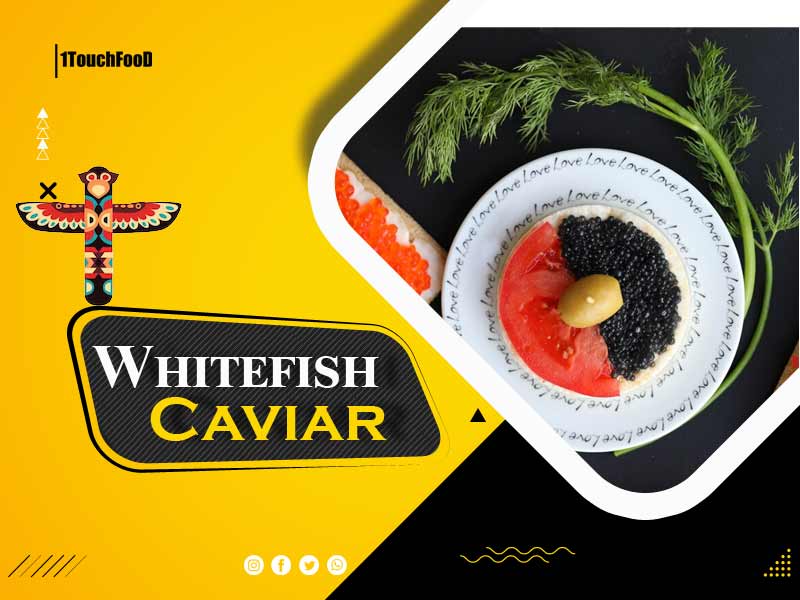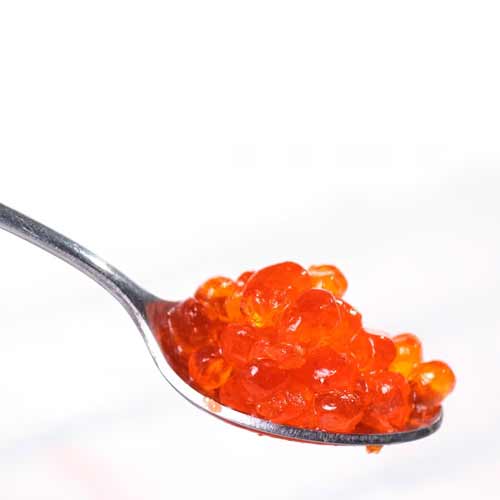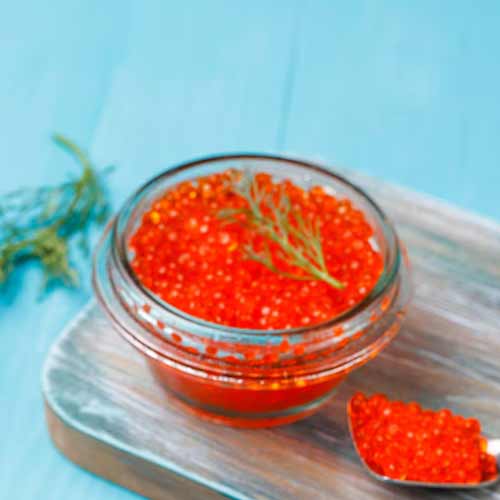Cooking time
- Preparation time
- 10 mins
- Cooking time
- 20 mins
- Difficulty
- moderate
- Serves
- 4 people
- Meal course
- Dinner
- Posted by
- Posted on
- September 16, 2023
Ingredients
- 1 cup
- whitefish caviar
- 1 cup
- buckwheat flour
- 1 cup
- all-purpose flour
- 1 cup
- Yogurt
- 1 cup
- sour cream
- 2 large
- Eggs
- 1 cup
- Butter
- 4 large
- potato
- 1 cup
- Chives
- 2 Ts
- Lemon juice
- 0 As Needed
- salt and pepper

Whitefish caviar is a delicate and precious seafood treat that is enjoyed by foodies and epicures the world over. This rare delicacy is derived from the roe of certain species of whitefish, including lake whitefish, beluga, and Siberian sturgeon.
Enjoying Whitefish Caviar:

- Whitefish Caviar has a delicate and mildly briny flavor. It pairs wonderfully with a glass of chilled champagne or sparkling wine.
When it comes to whitefish caviar dishes, the options are endless! Here are some creative ways to prepare and enjoy this luxurious treat:
- Blini: These fluffy, Russian-style pancakes are a perfect vehicle for whitefish caviar. Top them with sour cream, chives, and a dollop of caviar for an elegant appetizer or brunch dish.
- Osetra: This type of whitefish caviar is highly prized for its briny, slightly nutty flavor. Enjoy it as is with a glass of chilled champagne for a truly luxurious experience.
- Baked potatoes: This classic comfort food gets a luxury upgrade with a dollop of whitefish caviar on top. Add some butter, sour cream, and chopped chives for a hearty meal that’s sure to satisfy.
- Sushi rolls: Whitefish caviar adds a beautiful pop of color and a briny, umami flavor to your favorite sushi rolls. Try it in a California roll or a tuna roll for an elevated bite.
- Bloody Mary: This popular cocktail gets a fancy twist with a scoop of whitefish caviar on top. Add some celery, lemon, and a dash of Worcestershire sauce for a gourmet treat that’s sure to impress.
- Deviled eggs: These miniature egg snacks are taken to the next level with a topping of whitefish caviar. Add some diced chives and a pinch of paprika for a colorful and flavorful appetizer.
Whitefish caviar, made from the roe of certain whitefish species, is a rare and precious delicacy that has been savored by culinary enthusiasts for centuries. Throughout history, whitefish caviar has been considered a symbol of status and opulence, often reserved for special occasions and royal courts.
The earliest documented use of this food can be traced back to ancient Greek and Roman societies, where it was a popular culinary ingredient and a status symbol. The Roman emperor Augustus was known to serve whitefish caviar at lavish banquets, and it was also a prized ingredient in the kitchens of medieval Europe.
In the 18th century, this food became a coveted commodity in Russia, where it was harvested from the beluga sturgeon and lake whitefish. The first commercial harvesting operation for whitefish caviar was established in the early 20th century in the United States, which helped to increase its popularity in America and other parts of the world.
Today, this food continues to be a highly sought-after delicacy in culinary circles, often served as a garnish for dishes such as blini, osetra, and baked potatoes. With its unique briny flavor and elegant appearance, whitefish caviar is one of the most sought-after ingredients in the world of fine dining.
Tips On Making Whitefish Caviar Dishes

Making and serving this food dishes can be an exciting and rewarding experience, but there are a few key tips to keep in mind to ensure the utmost success. Here are some of the most important considerations to keep in mind when it comes to creating and serving whitefish caviar dishes:
- Sourcing high-quality whitefish caviar: This is perhaps the most important consideration when it comes to creating and serving whitefish caviar dishes. Whitefish caviar is an exceptionally delicate and valuable product, which means that sourcing it from the highest-quality sources is an absolute must. Look for roe that is harvested from the finest species, such as lake whitefish, beluga, and Siberian sturgeon, and that is handled with the utmost care.
- Choosing the right presentation: The presentation of a whitefish caviar dish can be a true work of art, and selecting the right vessel and the right ingredients to present the roe is of utmost importance. For traditional whitefish caviar dishes, blini are often the preferred presentation, but there are countless other options available as well. Experiment with different vessels, such as small spoons, shot glasses, and even mini tart shells, to create a unique and memorable presentation.
- Focusing on flavor: This food is an exceptionally delicate and nuanced product, which means that it is important to pair it with ingredients that complement its flavors rather than overpowering it. Look for herbs and spices that will enhance the tastes of the roe, such as chives, parsley, and dill, as well as dairy products, such as cream, sour cream, and butter. These will not only complement the flavors of the roe, but also create a rich and creamy texture that pairs beautifully with the delicate taste of the roe.
- Considerating the seasoning: This food is a natural product, which means that it already possesses a unique and nuanced flavor profile. However, it is still essential to consider the seasoning of a whitefish caviar dish, as the right seasoning can enhance its flavors and transform it into something truly special. Look for the right balance of salt and pepper, as well as ingredients such as lemon and capers, to create a unique and memorable flavor profile.
- Experimenting with different ingredients: This food dishes can be an incredible platform for creativity and experimentation. While traditional whitefish caviar dishes, such as blini, are always a solid choice, there are countless other ingredients that can
Top Health Benefits of Whitefish Caviar Dishes

While whitefish caviar is often associated with luxury and indulgence, it actually has several health benefits that make it worth incorporating into your diet. Here are some of the health benefits of this food:
- Omega-3 fatty acids: This food is an excellent source of omega-3 fatty acids, which are essential for brain and heart health. Omega-3 fatty acids are also known to reduce inflammation and protect against various types of chronic diseases, such as heart disease and cancer.
- Antioxidants: This food is an excellent source of antioxidants, which can help protect the body against cell damage caused by free radicals. Antioxidants are known to help reduce the risk of various chronic diseases, such as cancer, heart disease, and diabetes.
- Vitamin B12: This food is an excellent source of vitamin B12, which is essential for the production of red blood cells and neurological function. Vitamin B12 deficiency can lead to symptoms such as fatigue, weakness, and cognitive issues.
- Protein: This food is an excellent source of protein, which is essential for growth and repair of tissues in the body. Protein is also essential for maintaining muscle mass and promoting healthy weight loss.
- Heart health: The EPA and DHA omega-3 fatty acids in whitefish caviar are known to help lower cholesterol and reduce the risk of heart disease. Whitefish caviar also contains vitamin B12, which is essential for heart health.
Overall, while this food is certainly a delicious and indulgent food, it also has plenty of health benefits that make it worth including in your diet. As with any food, it’s important to enjoy whitefish caviar in moderation as part of a balanced diet, but incorporating it into your diet regularly can add some excellent health benefits.
Frequently Asked Questions
- Can you eat whitefish caviar raw?
Yes, you can eat whitefish caviar raw. It is often served as a delicacy on bliny with sour cream and chives.
- Can you eat whitefish caviar with dairy products?
Yes, This food is often served with dairy products, such as sour cream, creme fraiche, or butter.
- What are the health benefits of whitefish caviar?
This food is an excellent source of omega-3 fatty acids, which have numerous health benefits, including reducing inflammation, protecting against chronic diseases, and supporting heart health. Whitefish caviar is also an excellent source of vitamin B12, protein, and antioxidants, which have additional health benefits.
- Can you eat whitefish caviar on its own?
Yes, you can eat whitefish caviar on its own, as a delicacy or as a hors d’oeuvre with a glass of champagne or another sparkling wine. It can also be added to a variety of dishes, from salads to pizzas to pastas, for a luxurious touch.
- What is the best way to serve whitefish caviar?
There are several delicious ways to serve whitefish caviar, including blini or other small pastries topped with whitefish caviar, sour cream, chive, and a sprinkle of pepper. It can also be served with fresh fruits such as strawberries, grapes, and blackberries, or added to a salad or a pasta dish. It can also be used as a topping for scrambled eggs or pancakes.
- Can whitefish caviar be eaten with breakfast?
Yes, This food can be eaten with breakfast. It is a delicate and luxurious ingredient that can be added to things like scrambled eggs, omelets, or even breakfast sandwiches for an indulgent and luxurious start to the day. It is also often served as a breakfast appetizer in fine dining establishments.
- Is This food an acquired taste?
This food is not necessarily an acquired taste, but some people may find the flavor to be strong or briny at first. It is recommended to start with small amounts of whitefish caviar, and to try it with different garnishes or preparations, in order to develop a taste for it. Additionally, whitefish caviar can be paired with flavors that complement its briny and luxurious flavor to make it more palatable.
- What is the recommended serving size of whitefish caviar?
The recommended serving size for whitefish caviar is generally considered to be 1-2 teaspoons. However, it’s important to note that the serving size may vary depending on personal preference and the dish it is being served with.
Additionally, due to the high cost of whitefish caviar, it’s often served as a gourmet or luxury ingredient, and may be enjoyed in small amounts as a delicacy. It’s important to keep in mind that excess consumption of whitefish caviar could be detrimental to health and wallet, and it’s always a good idea to enjoy it in moderation.
- Can whitefish caviar be eaten with alcohol?
Yes, whitefish caviar can be eaten with alcohol. However, it’s important to remember that alcohol can enhance the flavors and aromas of food, and may make the briny, luxurious flavor of whitefish caviar more pronounced. It’s recommended to be mindful of how much alcohol and whitefish caviar are consumed and to enjoy them in moderation.
- Can This food be frozen or refrigerated?
This food can be frozen or refrigerated to preserve its freshness. It’s important to note that freezing or refrigeration can affect the flavor and texture of whitefish caviar, so it’s recommended to keep it frozen or refrigerated for as short a time as possible. Additionally, it’s important to keep whitefish caviar in an air-tight container to prevent oxidation and contamination.
- What is the recommended storage temperature for whitefish caviar?
The recommended storage temperature for whitefish caviar is between 25-35°F (1-2°C), as this will help slow down its degradation and maintain its quality and freshness. It’s important to keep whitefish caviar in an air-tight container to prevent oxidation and contamination. Additionally, it’s important to avoid extreme temperatures, such as direct sunlight, heat, and humidity, which can also cause whitefish caviar to degrade faster.
- Can whitefish caviar cause a cholesterol spike?
This food, like all animal-based foods, contains cholesterol. The amount of cholesterol consumed can impact your cholesterol levels and heart health. It’s important to consume whitefish caviar and other animal-based foods in moderation, as part of a balanced diet that includes plenty of fruits, vegetables, whole grains, and lean proteins. It’s also important to discuss your diet and health with a trained healthcare professional to determine what’s right for you.
- Can whitefish caviar be eaten with other types of fish?
Yes, This food can be eaten with other types of fish, such as salmon, tuna, trout, or scallops. It can add an extra layer of flavor and texture to these types of dishes. It can also be used as a topping for fish tacos, fish burgers, or fish and chips. However, it’s important to be mindful of the portions and ingredients being used to avoid overwhelming the dish or making it too rich.
- Is This food a seasonal product?
This food is not a seasonal product in the traditional sense, as it can be enjoyed throughout the year. However, the production of whitefish caviar may be influenced by factors such as weather, water temperature, and the availability of fish, which could cause some fluctuations in availability. Additionally, different regions or areas may have different harvest seasons for whitefish caviar, which can also affect availability.
- What are the most common whitefish used for kaviar?
The most common whitefish used for kaviar are sturgeon, trout, salmon, and herring. Sturgeon kaviar is considered to be the highest quality and most expensive this food, while trout and salmon kaviar are more affordable and approachable. Herring kaviar is also popular, due to its small size, which makes it more affordable and accessible to a wider audience.
- How long should this food be cured before consuming?
This food should be cured for at least 24 hours and up to 72 hours before consumption. This will allow the flavor to develop and the texture to soften, resulting in a more palatable and enjoyable experience. However, it’s important to note that the longer whitefish caviar is cured, the stronger the flavor and briny taste may become. Therefore, it’s important to experiment with different curing times to determine what is most pleasing to your taste buds.
- Can this food caviar be used on its own as a spread?
Yes, This food can be used on its own as a spread. It is often served with crackers as an appetizer, or used as a garnish on salads, sandwiches, and other dishes. It can also be used as a topping for potatoes, pasta, or even pizzas. However, it’s important to note that the flavor and texture of whitefish caviar can be intense and briny, so it’s recommended to start with smaller amounts and to experiment with different garnishes and preparations to find what works best for your taste buds.
- Is this food a good source of protein?
Yes, This food is a good source of protein. It is an excellent source of high-quality protein, which can help build and repair cells, muscles, and tissues in the body. It also contains all nine essential amino acids, which are necessary for the body to function effectively. Additionally, whitefish caviar is low in calories, making it a great option for individuals looking to increase their protein intake while maintaining a balanced diet. It is important to keep in mind that while this food is an excellent source of protein, it’s always a good idea to enjoy it in moderation and as part of a balanced diet that includes other protein-rich foods, such as lean meats, poultry, fish, nuts, eggs, and legumes.
- What is the recommended serving temperature for this food dishes?
Yes, This food is a good source of protein. It is an excellent source of high-quality protein, which can help build and repair cells, muscles, and tissues in the body. It also contains all nine essential amino acids, which are necessary for the body to function effectively. Additionally, whitefish caviar is low in calories, making it a great option for individuals looking to increase their protein intake while maintaining a balanced diet. It is important to keep in mind that while this food is an excellent source of protein, it’s always a good idea to enjoy it in moderation and as part of a balanced diet that includes other protein-rich foods, such as lean meats, poultry, fish, nuts, eggs, and legumes.
- Can this food be served on a salad?
Yes, This food can be served on a salad. It is often used as a garnish on green salads, grain salads, and fruit salads. It can also be used as a topping on more robust salads, such as chicken or tuna salad. Additionally, This food can be added to salads for texture, flavor, and nutrition. However, it’s important to keep in mind that the flavor and texture of whitefish caviar can be intense and briny, so it’s recommended to start with smaller amounts and to experiment with different garnishes and preparations to find what works best for your taste buds.
Please follow us on linkedin. You can learn all best canadian food recipes you can check our Culinary 1TouchFood Youtube and Telegram 1TouchFood page. Don’t forget Fighting Obesity Magazine and Radio Cooking.
Instructions
- For Blini with Whitefish caviar, In a medium bowl, whisk together the buckwheat flour and all-purpose flour. In a separate bowl, whisk together the yogurt, cream, eggs, and sour cream until well combined.
- Add the wet ingredients to the dry ingredients and whisk until a smooth batter forms.
- Heat a nonstick pan over medium heat. Add a dollop of melted butter to the pan, tilting to cover the surface of the pan for even cooking.
- Scoop about 2 tablespoons of the batter into the hot pan, making small pancakes the size of silver dollars.
- Cook until the pancakes are lightly browned on both sides, about 2 minutes per side.
- Transfer the pancakes to a plate and continue cooking the rest of the batter, adding more butter to the pan as necessary.
- Place a spoonful of whitefish caviar on top of each blini and serve immediately.
- For preparing potatoes with whitefish caviar, first preheat the oven to 400°F.
- Scrub the potatoes clean and dry them well. Rub them all over with salt and prick them several times with a fork.
- Bake the potatoes in the preheated oven for 1 hour, until cooked through.
- While the potatoes are cooking, make the topping by combining the sour cream, chives, and lemon juice in a small bowl. Season with salt and pepper to taste.
- When the potatoes are done cooking, cut them in half lengthwise and scoop out the inside, leaving a thin shell. Season the inside with salt and pepper.

No comments yet, be the first to leave one!